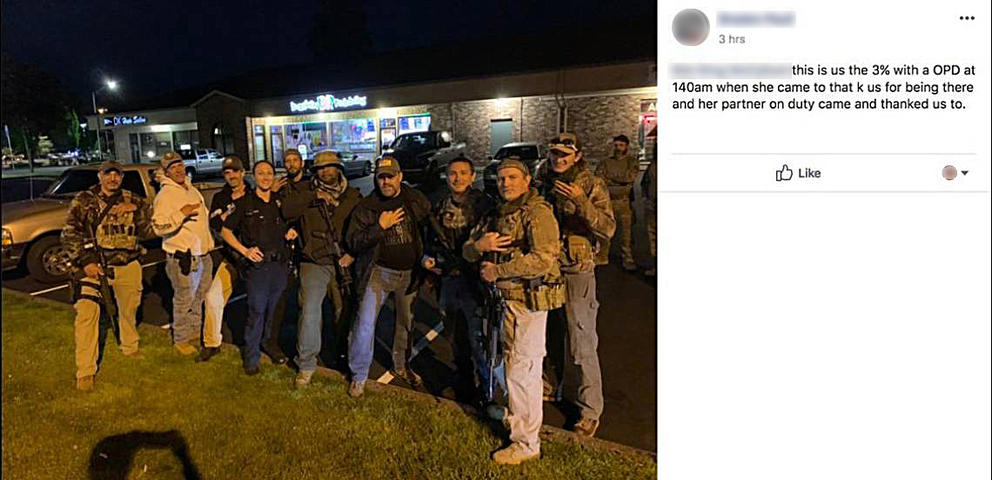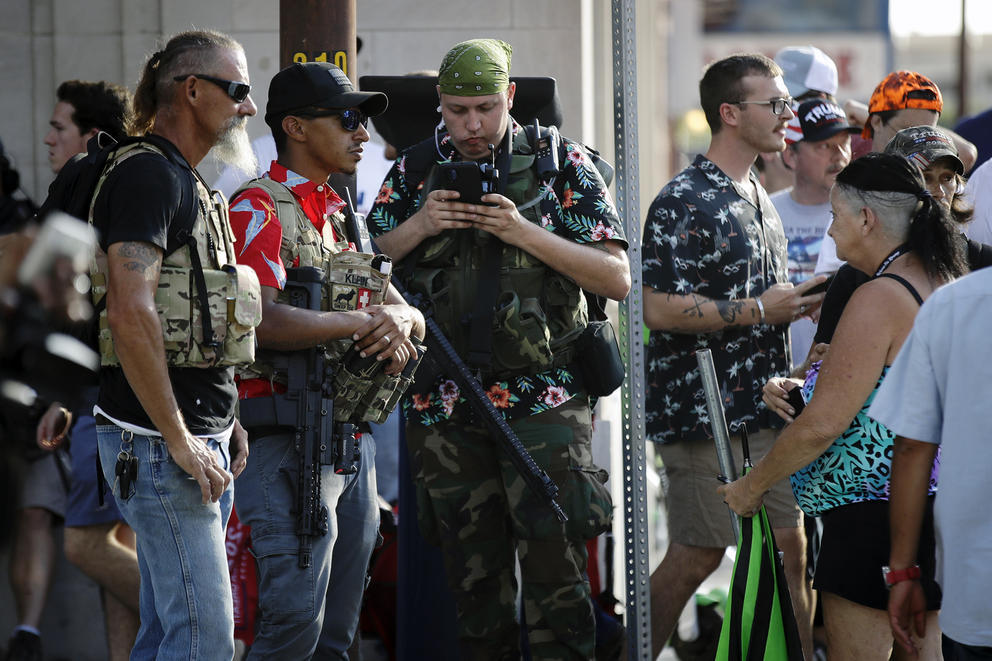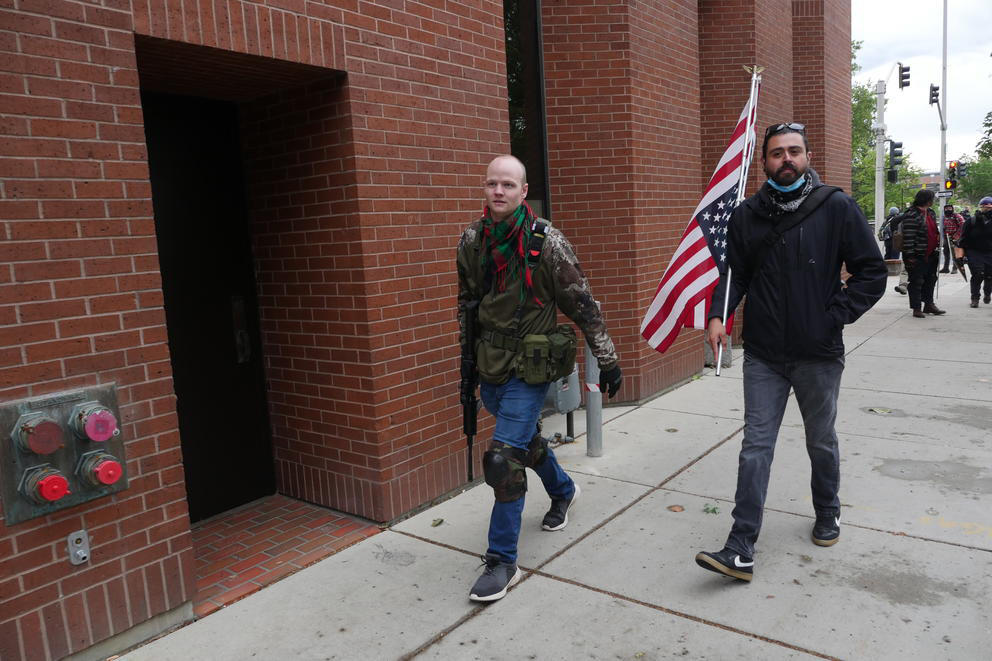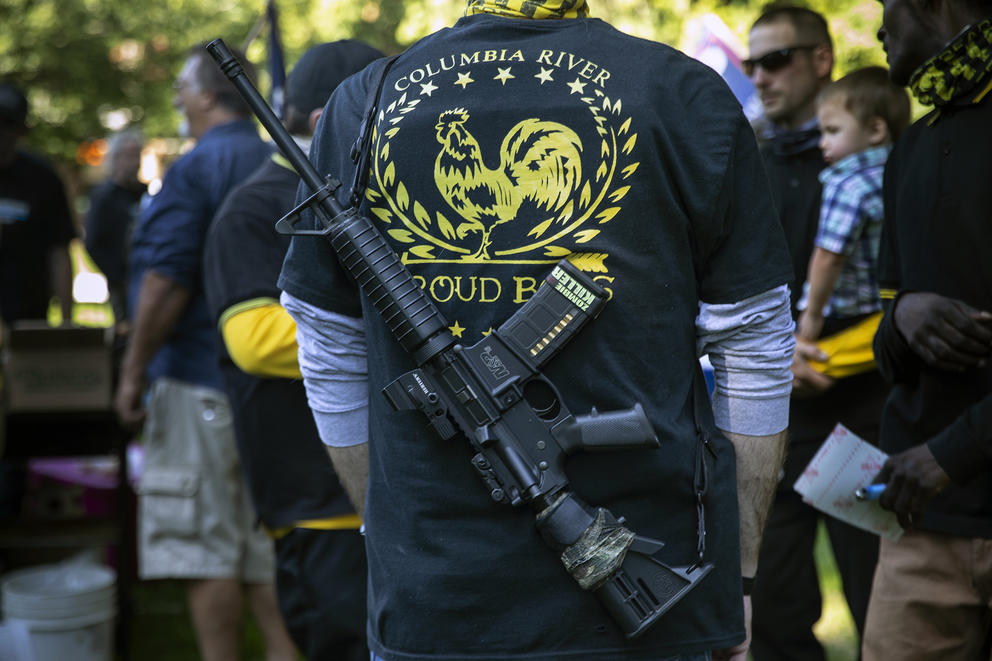Posted on social media as the Black Lives Matters protests unfolded in June, that photo of a grinning cop surrounded by armed, camouflage-clad men fed the worst fears of residents who for days had complained to police about armed men following and intimidating protesters. It was proof to some that police, amid an upsurge in guns sales, were coddling vigilantes they should be arresting.
“As a Black woman, I am scared right now … to live in a ZIP code where officers actively affiliate themselves with armed, white vigilantes, who have made their paranoid, suspicious hatred of my people an inescapable presence in my life,” Olympia resident Elisa McGee told the city council in June. She demanded that Coates be fired. That didn’t happen. (In fact, this month she was honored as “Officer of the Year” by the Olympia post of the American Legion.)
Now, as a contentious Election Day approaches, the ability of law enforcement to respond to vigilantes and possible paramilitary actions remains an open and pressing question.
InvestigateWest is a Seattle-based nonprofit newsroom producing journalism for the common good. Learn more and sign up to receive alerts about future stories here.
Paramilitary organizations are illegal in Washington and many other states. But the laws meant to stop the formation of ad hoc armies are archaic and vague, so much so that police and prosecutors who have had the opportunity to use those laws recently describe them as unenforceable.
Not that any have tried. Despite the rise in paramilitary activity, nowhere in the state have members of those armed, organized groups been prosecuted for violations of the state’s anti-paramilitary laws, according to interviews with law enforcement leaders and extremism experts. Rather than being prosecuted, the melange of AR-15-carrying, camouflage-clad vigilante groups has been called on by a handful of politicians to provide “security,” as President Donald Trump suggested that one high-profile group “stand back and stand by.”
Tensions are high as hundreds of members of the Washington National Guard are ready to support local police if civil unrest does break out. That unrest could manifest in a number of ways — including protests much like those seen this summer — but the possibility of paramilitary action presents a particular unknown.
Karina Shagren, a spokesperson for the Washington state Military Department, said the National Guard hasn’t deployed but is poised to do so if there are disturbances around Election Day.
“It’s safe to say this is a risk that we need to be prepared for,” Shagren said. “It would be a disservice not to.”
Should violence occur, it won’t have come without warning. Police and prosecutors around the state have been trying to figure out what to do about the upwelling of vigilantism for months, to little effect.
What constitutes an illegal militia?
Laws related to paramilitary activities vary slightly state to state, but the key features are similar. Washington’s are no exception.
“If a group is carrying assault rifles and coordinating its deployment of individuals … that’s activity that we would typically call paramilitary activity,” said Mary McCord, legal director of Georgetown Law School’s Institute for Constitutional Advocacy and Protection.
Recently, McCord has helped bring lawsuits against paramilitary groups. After the 2017 Unite the Right rally in Charlottesville, Virginia, her organization successfully sued to block paramilitaries from returning to the state. Her organization has since helped city and county governments stop illegal paramilitary conduct in their jurisdictions.
Though he recently stepped down as Three Percent of Washington’s leader, group founder Matt Marshall remains adamant that the group is not a paramilitary organization. Proponents of the Three Percent movement, which takes its name from the debunked notion that only 3% of colonists fought in the American Revolution, present themselves as civilian opposition to tyranny; some celebrate anti-government actions like the 2014 standoff at Cliven Bundy’s Nevada ranch.
Groups in the Three Percent movement and other vigilantes have nonetheless been embraced by some elected officials. A handful even invited them to “protect” their towns.
One Idaho county commissioner invited citizens to come “help counter anything that might get out of hand” at a Sandpoint, Idaho, Black Lives Matter protest in June, while in Coeur d’Alene officials claimed incorrectly that the U.S. Constitution enables organized armed groups to patrol the city during protests. In the Olympia suburb of Lacey, Cty Councilmember Ed Kunkel posted on Facebook that armed private paramilitaries patrolling the streets of Coeur d’Alene was “how it should be.”
Those stamps of legitimacy land on a diffuse movement that has seen adherents accused of planning to kidnap Democratic governors in Michigan and Virginia, brandish firearms during political disagreements and clash violently with protesters on the opposing side. Portland’s riotous summer, and now fall, saw right-wing vigilantes squared off with racial justice demonstrators; one antifa-affiliated demonstrator suspected in the killing of a member of an armed right-wing group in Portland was shot dead by members of a federal task force in September.
New report reveals threat
In a report released Wednesday, researchers with the Armed Conflict Location & Event Data Project and MilitiaWatch stated that militia groups “pose a serious threat to the safety and security of American voters” as the election nears, in part because they’ve faced few consequences.
“The lack of open sanctions of these groups … has given them space to operate, while concurrently allowing political figures to claim little direct responsibility for violent actions from which they hope to benefit,” the authors said in the report.
Many protesters find the paramilitaries intimidating, said Devin Burghart, executive director of the Institute for Research and Education on Human Rights. The groups, overwhelmingly white in their membership, have become increasingly common at protests targeting racism and white supremacy.
“The fear that it strikes in folks to see groups of heavily armed men walking through the streets is something that can’t be understated,” said Burghart, whose Seattle-based organization tracks far-right groups. He added that people who’ve lived in countries where paramilitary death squads were given free rein find them particularly chilling.
In Washington alone, there were at least 15 incidents of far-right groups showing up at Black Lives Matter demonstrations in the month following George Floyd’s killing by Minneapolis police on May 25. During that time, there were 136 sightings of far-right groups at racial justice protests in the U.S., according to a map produced in part by Burghart's institute. News outlets reported armed vigilantes at protests in Olympia, Snohomish, Spokane, the Tri-Cities and Gig Harbor.
Despite the upswing, it appears that nowhere in the state have anti-paramilitary criminal laws been enforced.
While state laws typically do not use the words “militia” or “paramilitary,” Washington has three criminal laws that can potentially be applied to paramilitary conduct. One prohibits groups from forming military companies, while another prohibits training others to create civil disorder, and a third makes it illegal to impersonate police.
The laws do not discuss ideology, and would apply regardless of political affiliation. A few groups on the left are arming themselves as well. In Seattle, the leftist group Puget Sound John Brown Gun Club has appeared armed at protests and provided security for speakers at the Capitol Hill Organized Protest.
Spokane Police Department spokesperson John O’Brien said he has never seen Washington’s paramilitary statutes enforced, and noted the vigilantes have largely complied with officers’ orders.
After the first night of protests in the wake of Floyd's killing, O’Brien said, the Spokane police met with the county prosecutors to discuss possible charges against armed vigilantes. None were prosecuted, and it’s unclear whether the state laws related to private paramilitary conduct came up. The Spokane County Prosecutor’s Office did not respond to a request for comment.
Snohomish County Prosecutor Adam Cornell said that in his 18 years as a prosecutor he can’t recall ever seeing an investigation that used Washington’s private paramilitary statutes. Cornell, whose jurisdiction includes a town that saw 100 armed vigilantes praised by the city’s mayor after “patrolling” the streets in late May, said he believes they would be difficult charges to prove.
“I don’t believe that the police are investigating violations of” Washington’s private paramilitary statutes by the vigilantes, Cornell continued.
If police were looking to bring cases against vigilantes, the Prosecutor’s Office would likely have received requests that charges be filed, Cornell said. Snohomish County Sheriff Adam Fortney, whose department provides police services in many of the county’s cities, did not respond to A request for comment.
The broad absence of action against the armed vigilantes, and the apparent endorsement by some prominent Republicans, has led some to wonder where law enforcement sympathies lie.
The campaign for Loren Culp, an Eastern Washington police chief hoping to unseat Gov. Jay Inslee, gave $7,000 to the founder of one vigilante group that later claimed to have raised $55,000 for the teen who fatally shot two Black Lives Matter demonstrators and wounded a third in Kenosha, Wisconsin.
In late August, the Brennan Center for Justice released a report noting ties between police departments and white supremacist or militia groups have been uncovered since 2000 in 14 states. The center noted the firing of a southwest Washington sheriff’s deputy tied to the Proud Boys, an all-male neo-fascist organization. Michael German, a former FBI special agent, told The Guardian that the scale of links between law enforcement and extremist groups is difficult to determine because no one is collecting that data.
Burghart from Institute for Research and Education on Human Rights said he has seen numerous incidents where anti-paramilitary statutes should have been applied in the Pacific Northwest, but that authorities made virtually no effort to use them. He attributes the hesitation to lack of political will and concern over turning vigilantes into martyrs.
“There is no roadmap for a county prosecutor or a state attorney general to prosecute any of these paramilitary groups, because it hasn’t been done,” Burghart said. “Nobody wants to be the first. Nobody wants to lose a case like that.”
A man in a Proud Boys shirt and carrying a gun is seen during a memorial for Aaron J. Danielson, Sept. 5, 2020, in Vancouver, Washington. Danielson, a supporter of the conservative group Patriot Prayer, was fatally shot in August as supporters of President Trump and Black Lives Matter protesters clashed in Portland. (Paula Bronstein/AP)
The Three Percent of Washington, Burghart said, has “worked really hard to say that they are not a militia” while engaging in paramilitary activities.
While the paramilitary statutes are criminal statutes and police can make arrests, McCord, legal director of the Institute for Constitutional Advocacy and Protection, doesn’t necessarily recommend that as a first step.
“That sometimes can just escalate a whole situation into violence,” she said. Police “need to use their judgment in any given incident.”
After the Olympia officer was seen on Facebook with the Three Percent group, the Olympia Police Department launched a three-month internal investigation that cleared Officer Coates. Olympia Police Chief Aaron Jelcick explained in an interview with InvestigateWest that it is simply too difficult to tell what constitutes a militia group.
Police came to learn the Three Percent of Washington members arrived in Olympia to, in their view, defend the city. Patches worn by some showed they belonged to the organization’s 75-member unit covering a five-county region that includes the state capital. Most said they were veterans, and that their statewide organization — which describes itself as a group of “God-fearing Patriots that support our constitution” — backs the aims of the Black Lives Matter movement. They said they were there to defend against Antifa.
Jelcick expressed concern that clashes between justice reform demonstrators and self-styled security forces would result in “unintended consequences.” The police, Jelcick said, did not need assistance from “any militia, any armed civilians, or any vigilante groups.” Thirty-three elected leaders in Thurston County also signed a letter opposing the vigilantes.
But Jelcick’s investigators did not try to build a criminal case against the paramilitaries. Looking back, Jelcick said he still doesn’t believe police could have.
“If you have people that are cruising around and assuming the role of a military organization or law enforcement agency, it needs to be clear that they are doing that,” Jelcick said. “Simply being a group of people that convene in a parking lot is not going to meet that criteria.”
Marshall, Three Percent of Washington’s founder, agreed.
Drawing a line between his organization and vigilante groups that go to demonstrations looking for a fight, Marshall described Three Percent of Washington as a service-minded group that, when not heading to protests, conducts food drives and helps homeless veterans. He sees the registered nonprofit as a less organized version of a Rotary club.
“I have told people over, and over, and over again not to wear military-looking gear, [body armor] plate carriers or camo in public because it completely destroys the image that we’re going for,” Marshall said. “Nobody looks at us and thinks ‘Oh, those look like a bunch of normal, sane people that we want to go talk to.’ ”
Responding to the criticism that Three Percent of Washington takes on work properly done by police, Marshall noted that some arguing that the police be defunded also believe the community “can do it themselves.”
Even among extremism experts, there is disagreement about what makes a group paramilitary.
Three leading watchdog groups — The Southern Poverty Law Center, Western States Center and Institute for Research and Education on Human Rights — all consider the Three Percent of Washington a paramilitary organization. Mark Pitcavage, a senior research fellow at the Anti-Defamation League’s Center on Extremism, does not.
“I wouldn’t call them a paramilitary group,” Pitcavage said. “I don’t think there is enough of a paramilitary structure to them to call them that, but they are certainly an armed extremist group.”
Lindsay Schubiner is a program director at the Western States Center, an organization that advocates for inclusive democracy. She noted that right-wing paramilitary groups are “keen observers of political conditions.”
“We have seen paramilitary and alt-right groups in the Northwest and across the country [exploit] the pandemic as a time of political instability,” Schubiner said. “It’s critical that law enforcement and elected officials not lend credibility to militia or paramilitary groups.”
In Olympia, it appeared Three Percent of Washington was attempting to link up with police the night of the photo with police officer Tiffany Coates. The department’s internal investigation revealed that Three Percent of Washington’s local chapter leader asked Coates to put him in touch with her superiors. Coates told investigators the vigilante wanted to “let us know that they’re peaceful … and that they believe in the Black Lives Matter movement.”
Jelcick said the Olympia Police Department does not take “one side or another” when opposing groups protest. If they are likely to clash, he said, officers discourage them from interacting with each other.
“That’s what we have done,” Jelcick said. “But if we have somebody clearly violating the law, we are going to engage those folks if it’s safe to do so.”
This story has been updated to correct the spelling of Karina Shagren's name, which was misspelled on second reference.







